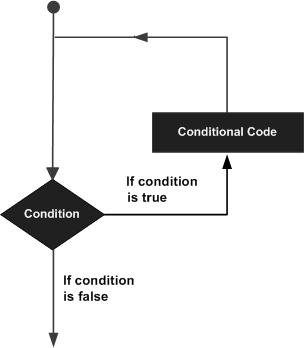Java - Loop Control
There may be a situation when you need to execute a block of code several number of times. In general, statements are executed sequentially: The first statement in a function is executed first, followed by the second, and so on.
Programming languages provide various control structures that allow for more complicated execution paths.
A loop statement allows us to execute a statement or group of statements multiple times and following is the general form of a loop statement in most of the programming languages −

Java programming language provides the following types of loop to handle looping requirements.
[1]. LoopThe syntax of a while loop is −
while(Boolean_expression) {
// Statements
}public class Test { public static void main(String args[]) { int x = 10; while( x < 20 ) { System.out.print("value of x : " + x ); x++; System.out.print("\n"); } } }
This will produce the following result −
Outputvalue of x : 10 value of x : 11 value of x : 12 value of x : 13 value of x : 14 value of x : 15 value of x : 16 value of x : 17 value of x : 18 value of x : 19
The syntax of a for loop is −
for(initialization; Boolean_expression; update) {
// Statements
}
Here is the flow of control in a for loop −
- The initialization step is executed first, and only once. This step allows you to declare and initialize any loop control variables and this step ends with a semi colon (;).
- Next, the Boolean expression is evaluated. If it is true, the body of the loop is executed. If it is false, the body of the loop will not be executed and control jumps to the next statement past the for loop.
- After the body of the for loop gets executed, the control jumps back up to the update statement. This statement allows you to update any loop control variables. This statement can be left blank with a semicolon at the end.
- The Boolean expression is now evaluated again. If it is true, the loop executes and the process repeats (body of loop, then update step,
Following is an example code of the for loop in Java.
public class Test { public static void main(String args[]) { for(int x = 10; x < 20; x = x + 1) { System.out.print("value of x : " + x ); System.out.print("\n"); } } }
This will produce the following result −
Outputvalue of x : 10 value of x : 11 value of x : 12 value of x : 13 value of x : 14 value of x : 15 value of x : 16 value of x : 17 value of x : 18 value of x : 19
Following is the syntax of a do...while loop −
do {
// Statements
}while(Boolean_expression);public class Test { public static void main(String args[]) { int x = 10; do { System.out.print("value of x : " + x ); x++; System.out.print("\n"); }while( x < 20 ); } }
This will produce the following result −
Outputvalue of x : 10 value of x : 11 value of x : 12 value of x : 13 value of x : 14 value of x : 15 value of x : 16 value of x : 17 value of x : 18 value of x : 19
The syntax of a break is a single statement inside any loop −
break;
public class Test { public static void main(String args[]) { int [] numbers = {10, 20, 30, 40, 50}; for(int x : numbers ) { if( x == 30 ) { break; } System.out.print( x ); System.out.print("\n"); } } }
This will produce the following result −
Output10 20
The syntax of a continue is a single statement inside any loop −
continue;
public class Test { public static void main(String args[]) { int [] numbers = {10, 20, 30, 40, 50}; for(int x : numbers ) { if( x == 30 ) { continue; } System.out.print( x ); System.out.print("\n"); } } }
This will produce the following result −
Output10 20 40 50
As of Java 5, the enhanced for loop was introduced. This is mainly used to traverse collection of elements including arrays.
SyntaxFollowing is the syntax of enhanced for loop −
for(declaration : expression) {
// Statements
} - Declaration − The newly declared block variable, is of a type compatible with the elements of the array you are accessing. The variable will be available within the for block and its value would be the same as the current array element.
- Expression − This evaluates to the array you need to loop through. The expression can be an array variable or method call that returns an array.
Example
public class Test { public static void main(String args[]) { int [] numbers = {10, 20, 30, 40, 50}; for(int x : numbers ) { System.out.print( x ); System.out.print(","); } System.out.print("\n"); String [] names = {"James", "Larry", "Tom", "Lacy"}; for( String name : names ) { System.out.print( name ); System.out.print(","); } } }
This will produce the following result −
Output10, 20, 30, 40, 50, James, Larry, Tom, Lacy,
Comments
Post a Comment